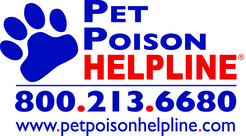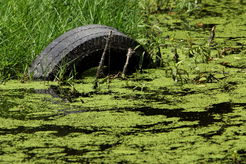- posted: May 18, 2018
Blue-Green Algae (Cyanobacteria) Toxicity
Lynn Hovda, RPh, DVM, MS, DACVIM
Director, Veterinary Services
Pet Poison Helpline

The onset of warm and humid weather increases the threat of blue-green algae poisoning in people, pets, and livestock that swim in or drink from contaminated water. Cyanobacteria (blue-green algae)are microscopic bacteria that “bloom” or colonize in bodies of fresh and brackish (not quite fresh, not quite salt) water. Algal blooms result in concentrations of hundreds to millions of algae in the water, often appearing as scum and turning the water a different color. Blooms are generally green (brilliant green, pea soup green, or iridescent), but different species of algae produce other colors such as orange/red or yellow/brown. In addition to changing the color of the water, blooms may cause an odor and/or abnormal taste to the water and irritation to the skin. Algae float on the surface and on windy days may be pushed together forming thick mats of concentrated algae.

Most cyanobacteria blooms are nontoxic and of the 2000 plus cyanobacteria species, only 80 or so cause poisoning. Poisonous blue-green algae blooms can occur throughout the year, but increase during hot summer days when the water temperature rises and rain water run-off results in more nutrients, such as phosphorous and nitrogen, in the water. It is impossible to determine toxicity simply by looking at the water so all blue-green algae blooms should be considered poisonous unless proven otherwise. Species of blue-green algae known to be toxigenic include Anabena, Aphanizomenon, Lyngbya, Microcystis, Oscillatoria, and Planktothrix. Microcystins, potent hepatotoxins, and anatoxins (anatoxin –a and anatoxin-as), powerful neurotoxins, are the important toxins produced by these species.
All animals, including dogs, cats, farm and wild animals, and birds, and humans are susceptible to the toxins produced by blue-green algae. Depending on the concentration of algae, only a few mouthfuls of contaminated water are often enough to cause fatal signs. Some absorption through the respiratory route as well as skin has been suggested. Dogs, especially water loving dogs that hunt or swim, are the species most commonly affected. Cats are seldom affected primarily because they rarely swim and are unlikely to drink water that is not fresh. Common sources of poisoning include backyard ponds and stagnant water holes as well as lakes and slow moving streams. Water left in discarded aquariums and buckets of watery scum removed from ponds or waterholes and left indiscriminately around animals are potential sources of poisoning.
The onset of signs in animals exposed to blue-green algae is rapid. Animals ingesting water contaminated with microcystins generally become ill within 30 minutes after access to contaminated water. Early signs include anorexia, lethargy, vomiting, diarrhea, weakness, and pale mucous membranes followed by a rapid onset of shock and death. Some animals develop restlessness, recumbency, and seizures prior to death. Animals ingesting anatoxin-a develop cyanosis, respiratory failure, stiffness, and muscle tremors followed by paralysis and death in minutes to a few hours. In addition to the signs seen with anatoxin-a, animals ingesting anatoxin-as often present with salivation, lacrimation, excess urination, and diarrhea.
There is no specific treatment for poisoning from blue-green algae toxins. The rapid onset of clinical signs precludes at home treatment and many animals die within 30 minutes of exposure to contaminated water. Exposed animals should be rapidly rinsed to prevent further contamination and taken immediately to their veterinarian. Blue - green algae are a human toxin and individuals handling affected animals need to take safety precautions to protect themselves. While the outcome is often poor, animals have survived with early and aggressive care. Consultation with the staff at Pet Poison Helpline is recommended to assist with the management of these difficult cases.
Article courtesy of Pet Poison Helpline
Hospital Hours
Please call, text, or use PetDesk to make an appointment today! Last patient is seen at 4:30 pm Monday-Friday and by 11:30am on Saturday.
Monday
7:30 am - 5:30 pm
Tuesday
7:30 am - 5:30 pm
Wednesday
7:30 am - 5:30 pm
Thursday
7:30 am - 5:30 pm
Friday
7:30 am - 5:30 pm
Saturday
7:30 am - 12:00 pm
Sunday
Closed
Monday
7:30 am - 5:30 pm
Tuesday
7:30 am - 5:30 pm
Wednesday
7:30 am - 5:30 pm
Thursday
7:30 am - 5:30 pm
Friday
7:30 am - 5:30 pm
Saturday
7:30 am - 12:00 pm
Sunday
Closed
Our Tampa Animal Hospital Location
Find us on the map
--mi
Dale Mabry Animal Hospital
Address
3606 S Dale Mabry Hwy
Tampa, FL 33629, USA





